Utilization of Cold Energy from LNG Regasification Process: A Review of Current Trends
Abstract
:1. Introduction
2. Trends of Current LNG Cold Energy Utilization
2.1. Power Generation
2.1.1. Rankine Cycle
2.1.2. Brayton Cycle
2.1.3. Kalina Cycle
2.2. Air Separation
2.3. Desalination of Seawater
2.4. CO2 Capture Using Cryogenic Process
3. Exploring the Potential and Future Applications of LNG Cold Energy in Various Sectors
3.1. Data Center Cooling
3.2. Storage of Cold Energy
4. Conclusions
Author Contributions
Funding
Data Availability Statement
Acknowledgments
Conflicts of Interest
References
- BP, p.l.c. BP Energy Outlook 2035: February 2015. 2015. Available online: https://www.bp.com/content/dam/bp/business-sites/en/global/corporate/pdfs/energy-economics/energy-outlook/bp-energy-outlook-2015.pdf (accessed on 22 December 2022).
- ExxonMobil Outlook For Energy: A Perspective to 2040. 2019. Available online: https://corporate.exxonmobil.com/-/media/Global/Files/outlook-for-energy/2019-Outlook-for-Energy_v4.pdf (accessed on 22 December 2022).
- Ritchie, H.; Roser, M.; Rosado, P. CO2 and Greenhouse Gas Emissions. Available online: https://ourworldindata.org/co2-and-other-greenhouse-gas-emissions (accessed on 23 December 2022).
- Lashof, D.A.; Ahuja, D.R. Relative Contributions of Greenhouse Gas Emissions to Global Warming. Nature 1990, 344, 529–531. [Google Scholar] [CrossRef]
- International Energy Agency. World Outlook Energy 2015; Organization for Economic Cooperation and Development OECD: Paris, France, 2015; ISBN 9789264243668. [Google Scholar]
- Şevik, S. An Analysis of the Current and Future Use of Natural Gas-Fired Power Plants in Meeting Electricity Energy Needs: The Case of Turkey. Renew. Sustain. Energy Rev. 2015, 52, 572–586. [Google Scholar] [CrossRef]
- Lim, W.; Choi, K.; Moon, I. Current Status and Perspectives of Liquefied Natural Gas (LNG) Plant Design. Ind. Eng. Chem. Res. 2013, 52, 3065–3088. [Google Scholar] [CrossRef]
- Mac Kinnon, M.A.; Brouwer, J.; Samuelsen, S. The Role of Natural Gas and Its Infrastructure in Mitigating Greenhouse Gas Emissions, Improving Regional Air Quality, and Renewable Resource Integration. Prog. Energy Combust. Sci. 2018, 64, 62–92. [Google Scholar] [CrossRef]
- Brown, S.P.; Krupnick, A.; Walls, M.A. Natural Gas: A Bridge to a Low-Carbon Future. Issue Br. 2009, 9–11. [Google Scholar]
- Tilagone, R.; Venturi, S.; Monnier, G. Natural Gas—An Environmentally Friendly Fuel for Urban Vehicles: The SMART Demonstrator Approach. SAE Tech. Pap. 2005, 61, 155–164. [Google Scholar] [CrossRef]
- Smil, V. Natural Gas: Fuel for the 21st Century; Wiley: New York, NY, USA, 2015; ISBN 9781119012849. [Google Scholar]
- Lochner, S.; Bothe, D. The Development of Natural Gas Supply Costs to Europe, the United States and Japan in a Globalizing Gas Market—Model-Based Analysis until 2030. Energy Policy 2009, 37, 1518–1528. [Google Scholar] [CrossRef]
- Mokhatab, S.; Mak, J.Y.; Valappil, J.V.; Wood, D.A. Handbook of Liquefied Natural Gas; Elsevier: Amsterdam, The Netherlands, 2013; ISBN 9780124046450. [Google Scholar]
- Ojijiagwo, E.; Oduoza, C.F.; Emekwuru, N. Economics of Gas to Wire Technology Applied in Gas Flare Management. Eng. Sci. Technol. Int. J. 2016, 19, 2109–2118. [Google Scholar] [CrossRef]
- Kumar, S.; Kwon, H.T.; Choi, K.H.; Hyun Cho, J.; Lim, W.; Moon, I. Current Status and Future Projections of LNG Demand and Supplies: A Global Prospective. Energy Policy 2011, 39, 4097–4104. [Google Scholar] [CrossRef]
- Kumar, S.; Kwon, H.T.; Choi, K.H.; Lim, W.; Cho, J.H.; Tak, K.; Moon, I. LNG: An Eco-Friendly Cryogenic Fuel for Sustainable Development. Appl. Energy 2011, 88, 4264–4273. [Google Scholar] [CrossRef]
- Liu, Y.; Wang, Y.; Huang, D. Supercritical CO2 Brayton Cycle: A State-of-the-Art Review. Energy 2019, 189, 115900. [Google Scholar] [CrossRef]
- Won, W.; Lee, S.K.; Choi, K.; Kwon, Y. Current Trends for the Floating Liquefied Natural Gas (FLNG) Technologies. Korean J. Chem. Eng. 2014, 31, 732–743. [Google Scholar] [CrossRef]
- Kim, S.K.; Park, S.-I.; Paik, J.K. Collision-Accidental Limit States-Based Safety Studies for a LNG-Fuelled Containership. Ocean Eng. 2022, 257, 111571. [Google Scholar] [CrossRef]
- Wang, M.; Zhang, J.; Xu, Q. A Novel Conceptual Design by Integrating NGL Recovery and LNG Re-Gasification Process for Maximum Energy Savings. AIChE J. 2013, 59, 4673–4685. [Google Scholar] [CrossRef]
- He, T.; Chong, Z.R.; Zheng, J.; Ju, Y.; Linga, P. LNG Cold Energy Utilization: Prospects and Challenges. Energy 2019, 170, 557–568. [Google Scholar] [CrossRef]
- Le, S.; Lee, J.Y.; Chen, C.L. Waste Cold Energy Recovery from Liquefied Natural Gas (LNG) Regasification Including Pressure and Thermal Energy. Energy 2018, 152, 770–787. [Google Scholar] [CrossRef]
- Guo, L.N.; An, B.L.; Chen, L.B.; Chen, J.X.; Wang, J.J.; Zhou, Y. Progress of Liquefied Natural Gas Cold Energy Utilization. IOP Conf. Ser. Mater. Sci. Eng. 2019, 502, 012148. [Google Scholar] [CrossRef]
- Jamali, S.; Yari, M. Recovery of Liquefied Natural Gas Cold Energy in a Clean Cogeneration System Utilizing Concentrated Photovoltaics. J. Clean. Prod. 2022, 350, 131517. [Google Scholar] [CrossRef]
- Mehrpooya, M.; Sharifzadeh, M.M.M.; Rosen, M.A. Optimum Design and Exergy Analysis of a Novel Cryogenic Air Separation Process with LNG (Liquefied Natural Gas) Cold Energy Utilization. Energy 2015, 90, 2047–2069. [Google Scholar] [CrossRef]
- Hirakawa, S.; Kosugi, K. Utilization of LNG Cold. Int. J. Refrig. 1981, 4, 17–21. [Google Scholar] [CrossRef]
- Kanbur, B.B.; Xiang, L.; Dubey, S.; Choo, F.H.; Duan, F. Cold Utilization Systems of LNG: A Review. Renew. Sustain. Energy Rev. 2017, 79, 1171–1188. [Google Scholar] [CrossRef]
- Zou, Q.; Yi, C.; Wang, K.; Yin, X.; Zhang, Y. Global LNG Market: Supply-Demand and Economic Analysis. IOP Conf. Ser. Earth Environ. Sci. 2022, 983, 12051. [Google Scholar] [CrossRef]
- Dutta, A.; Karimi, I.A.; Farooq, S. Economic Feasibility of Power Generation by Recovering Cold Energy during LNG (Liquefied Natural Gas) Regasification. ACS Sustain. Chem. Eng. 2018, 6, 10687–10695. [Google Scholar] [CrossRef]
- Xu, J.; Wang, X.; Sun, E.; Li, M. Economic Comparison between SCO2 Power Cycle and Water-Steam Rankine Cycle for Coal-Fired Power Generation System. Energy Convers. Manag. 2021, 238, 114150. [Google Scholar] [CrossRef]
- Herath, H.M.D.P.; Wijewardane, M.A.; Ranasinghe, R.A.C.P.; Jayasekera, J.G.A.S. Working Fluid Selection of Organic Rankine Cycles. Energy Rep. 2020, 6, 680–686. [Google Scholar] [CrossRef]
- Hung, T.C.; Shai, T.Y.; Wang, S.K. A Review of Organic Rankine Cycles (ORCs) for the Recovery of Low-Grade Waste Heat. Energy 1997, 22, 661–667. [Google Scholar] [CrossRef]
- Babatunde, A.F.; Sunday, O.O. A Review of Working Fluids for Organic Rankine Cycle (ORC) Applications. IOP Conf. Ser. Mater. Sci. Eng. 2018, 413, 012019. [Google Scholar] [CrossRef]
- Datla, B.V.; Brasz, J. Comparing R1233zd and R245fa for Low Temperature ORC Applications. Int. Refrig. Air Cond. Conf. 2014, 7. [Google Scholar]
- Gotelip Correa Veloso, T.; Sotomonte, C.A.R.; Coronado, C.J.R.; Nascimento, M.A.R. Multi-Objective Optimization and Exergetic Analysis of a Low-Grade Waste Heat Recovery ORC Application on a Brazilian FPSO. Energy Convers. Manag. 2018, 174, 537–551. [Google Scholar] [CrossRef]
- Lovegrove, K.; Pye, J. Chapter 2-Fundamental Principles of Concentrating Solar Power Systems. In Concentrating Solar Power Technology, 2nd ed.; Lovegrove, K., Stein, W., Eds.; Woodhead Publishing: Sawston, UK, 2021; pp. 19–71. ISBN 978-0-12-819970-1. [Google Scholar]
- Hisazumi, Y.; Yamasaki, Y.; Sugiyama, S. Proposal for a High Efficiency LNG Power-Generation System Utilizing Waste Heat from the Combined Cycle. Appl. Energy 1998, 60, 169–182. [Google Scholar] [CrossRef]
- Sun, Z.; Wang, S.; Xu, F.; He, W. Multi-Parameter Optimization and Fluid Selection Guidance of a Two-Stage Organic Rankine Cycle Utilizing LNG Cold Energy and Low Grade Heat. Energy Procedia 2017, 142, 1222–1229. [Google Scholar] [CrossRef]
- Baek, S.; Choi, W.; Kim, G.; Seo, J.; Lee, S.; Jeong, H.; Sung, Y. Liquefied Natural Gas Cold Energy Utilization for Land-Based Cold Water Fish Aquaculture in South Korea. Energies 2022, 15, 7322. [Google Scholar] [CrossRef]
- Daniarta, S.; Imre, A.R. Cold Energy Utilization in LNG Regasification System Using Organic Rankine Cycle and Trilateral Flash Cycle. Period. Polytech. Mech. Eng. 2020, 64, 342–349. [Google Scholar] [CrossRef]
- Liu, F.; Hu, X.; Yu, H.; Zhang, B. Cascaded Organic Rankine Cycles (ORCs) for Simultaneous Utilization of Liquified Natural Gas (LNG) Cold Energy and Low-Temperature Waste Heat. Lect. Notes Electr. Eng. 2020, 634, 418–423. [Google Scholar] [CrossRef]
- Choi, H.W.; Na, S.I.; Hong, S.B.; Chung, Y.; Kim, D.K.; Kim, M.S. Optimal Design of Organic Rankine Cycle Recovering LNG Cold Energy with Finite Heat Exchanger Size. Energy 2021, 217, 119268. [Google Scholar] [CrossRef]
- Joy, J.; Chowdhury, K. Appropriate Number of Stages of an ORC Driven by LNG Cold Energy to Produce Acceptable Power with Reasonable Surface Area of Heat Exchangers. Cryogenics 2022, 128, 103599. [Google Scholar] [CrossRef]
- Tian, C.; Su, C.; Yang, C.; Wei, X.; Pang, P.; Xu, J. Exergetic and Economic Evaluation of a Novel Integrated System for Cogeneration of Power and Freshwater Using Waste Heat Recovery of Natural Gas Combined Cycle. Energy 2023, 264, 126227. [Google Scholar] [CrossRef]
- Joy, J.; Kochunni, S.K.; Chowdhury, K. Size Reduction and Enhanced Power Generation in ORC by Vaporizing LNG at High Supercritical Pressure Irrespective of Delivery Pressure. Energy 2022, 260, 124922. [Google Scholar] [CrossRef]
- Tian, Z.; Qi, Z.; Gan, W.; Tian, M.; Gao, W. A Novel Negative Carbon-Emission, Cooling, and Power Generation System Based on Combined LNG Regasification and Waste Heat Recovery: Energy, Exergy, Economic, Environmental (4E) Evaluations. Energy 2022, 257, 124528. [Google Scholar] [CrossRef]
- Joy, J.; Chowdhury, K. Enhancing Generation of Green Power from the Cold of Vaporizing LNG at 30 Bar by Optimising Heat Exchanger Surface Area in a Multi-Staged Organic Rankine Cycle. Sustain. Energy Technol. Assess. 2021, 43, 100930. [Google Scholar] [CrossRef]
- Zhou, T.; Liu, J.; Ren, J.; Yang, S. Thermodynamic Analysis and Optimization of a Multi-Stage Rankine Cycle Power System Combining with Hydrate Energy Storage for Liquefied Natural Gas Cold Energy Utilization. J. Energy Storage 2022, 56, 105974. [Google Scholar] [CrossRef]
- He, T.; Ma, H.; Ma, J.; Mao, N.; Liu, Z. Effects of Cooling and Heating Sources Properties and Working Fluid Selection on Cryogenic Organic Rankine Cycle for LNG Cold Energy Utilization. Energy Convers. Manag. 2021, 247, 114706. [Google Scholar] [CrossRef]
- Pan, J.; Li, M.; Li, R.; Tang, L.; Bai, J. Design and Analysis of LNG Cold Energy Cascade Utilization System Integrating Light Hydrocarbon Separation, Organic Rankine Cycle and Direct Cooling. Appl. Therm. Eng. 2022, 213, 118672. [Google Scholar] [CrossRef]
- Shuailing, L.; Guoyuan, M.; Shuxue, X.; Yuexuan, G.; Xiaoya, J.; Guoqiang, W. A Review of Reverse Brayton Air Cycle Refrigerators. Int. J. Refrig. 2022, in press. [Google Scholar] [CrossRef]
- Khadse, A.; Blanchette, L.; Kapat, J.; Vasu, S.; Hossain, J.; Donazzolo, A. Optimization of Supercritical CO2 Brayton Cycle for Simple Cycle Gas Turbines Exhaust Heat Recovery Using Genetic Algorithm. J. Sol. Energy Eng. Trans. ASME 2018, 140, 071601. [Google Scholar] [CrossRef]
- Siddiqui, M.E.; Taimoor, A.A.; Almitani, K.H. Energy and Exergy Analysis of the S-CO2 Brayton Cycle Coupled with Bottoming Cycles. Processes 2018, 6, 153. [Google Scholar] [CrossRef]
- Cha, S.H.; Na, S.I.; Lee, Y.H.; Kim, M.S. Thermodynamic Analysis of a Gas Turbine Inlet Air Cooling and Recovering System in Gas Turbine and CO2 Combined Cycle Using Cold Energy from LNG Terminal. Energy Convers. Manag. 2021, 230, 113802. [Google Scholar] [CrossRef]
- Taheri, M.H.; Khani, L.; Mohammadpourfard, M.; Aminfar, H.; Akkurt, G.G. Multi-Objective Optimization of a Novel Supercritical CO2 Cycle-Based Combined Cycle for Solar Power Tower Plants Integrated with SOFC and LNG Cold Energy and Regasification. Int. J. Energy Res. 2022, 46, 12082–12107. [Google Scholar] [CrossRef]
- Chen, K.; Yu, H.; Fan, G.; Zhang, Y.; Dai, Y. Multi-Objective Optimization of a Novel Combined Parallel Power Generation System Using CO2 and N2 for Cascade Recovery of LNG Cryogenic Energy. Energy Convers. Manag. 2022, 256, 115395. [Google Scholar] [CrossRef]
- Sun, W.; Shang, L.; Pan, Z.; Liu, P.; Cui, X.; Zhu, J.; Sun, X. Performance Analysis and Optimization of a Novel Combined Cooling, Heating, and Power System-Integrated Rankine Cycle and Brayton Cycle Utilizing the Liquified Natural Gas Cold Energy. Energy Technol. 2022, 10, 2200632. [Google Scholar] [CrossRef]
- Bian, J.; Yang, J.; Li, Y.; Chen, Z.; Liang, F.; Cao, X. Thermodynamic and Economic Analysis of a Novel Hydrogen Liquefaction Process with LNG Precooling and Dual-Pressure Brayton Cycle. Energy Convers. Manag. 2021, 250, 114904. [Google Scholar] [CrossRef]
- Cao, Y.; Dhahad, H.A.; Togun, H.; Anqi, A.E.; Farouk, N.; Farhang, B. Proposal and Thermo-Economic Optimization of Using LNG Cold Exergy for Compressor Inlet Cooling in an Integrated Biomass Fueled Triple Combined Power Cycle. Int. J. Hydrogen Energy 2021, 46, 15351–15366. [Google Scholar] [CrossRef]
- Bi, Y.; Ju, Y. Design and Analysis of an Efficient Hydrogen Liquefaction Process Based on Helium Reverse Brayton Cycle Integrating with Steam Methane Reforming and Liquefied Natural Gas Cold Energy Utilization. Energy 2022, 252, 124047. [Google Scholar] [CrossRef]
- Angelino, G.; Invernizzi, C.M. The Role of Real Gas Brayton Cycles for the Use of Liquid Natural Gas Physical Exergy. Appl. Therm. Eng. 2011, 31, 827–833. [Google Scholar] [CrossRef]
- Kalina, A.I. Combined-Cycle System with Novel Bottoming Cycle. J. Eng. Gas Turbines Power 1984, 106, 737–742. [Google Scholar] [CrossRef]
- Wang, J.; Yan, Z.; Wang, M.; Dai, Y. Thermodynamic Analysis and Optimization of an Ammonia-Water Power System with LNG (Liquefied Natural Gas) as Its Heat Sink. Energy 2013, 50, 513–522. [Google Scholar] [CrossRef]
- Ghaebi, H.; Namin, A.S.; Rostamzadeh, H. Exergoeconomic Optimization of a Novel Cascade Kalina/Kalina Cycle Using Geothermal Heat Source and LNG Cold Energy Recovery. J. Clean. Prod. 2018, 189, 279–296. [Google Scholar] [CrossRef]
- Zhang, T.; Zhang, X.; Xue, X.; Wang, G.; Mei, S. Thermodynamic Analysis of a Hybrid Power System Combining Kalina Cycle with Liquid Air Energy Storage. Entropy 2019, 21, 220. [Google Scholar] [CrossRef]
- Ayou, D.S.; Eveloy, V. Integration of Municipal Air-Conditioning, Power, and Gas Supplies Using an LNG Cold Exergy-Assisted Kalina Cycle System. Energies 2020, 13, 4599. [Google Scholar] [CrossRef]
- Fang, Z.; Shang, L.; Pan, Z.; Yao, X.; Ma, G.; Zhang, Z. Exergoeconomic Analysis and Optimization of a Combined Cooling, Heating and Power System Based on Organic Rankine and Kalina Cycles Using Liquified Natural Gas Cold Energy. Energy Convers. Manag. 2021, 238, 114148. [Google Scholar] [CrossRef]
- Ghorbani, B.; Ebrahimi, A.; Moradi, M.; Ziabasharhagh, M. Continuous Production of Cryogenic Energy at Low-Temperature Using Two-Stage Ejector Cooling System, Kalina Power Cycle, Cold Energy Storage Unit, and Photovoltaic System. Energy Convers. Manag. 2021, 227, 113541. [Google Scholar] [CrossRef]
- Nabat, M.H.; Sharifi, S.; Razmi, A.R. Thermodynamic and Economic Analyses of a Novel Liquid Air Energy Storage (LAES) Coupled with Thermoelectric Generator and Kalina Cycle. J. Energy Storage 2022, 45, 103711. [Google Scholar] [CrossRef]
- Kim, D.; Giametta, R.E.H.; Gundersen, T. Optimal Use of Liquefied Natural Gas (LNG) Cold Energy in Air Separation Units. Ind. Eng. Chem. Res. 2018, 57, 5914–5923. [Google Scholar] [CrossRef]
- Chen, S.; Dong, X.; Xu, J.; Zhang, H.; Gao, Q.; Tan, C. Thermodynamic Evaluation of the Novel Distillation Column of the Air Separation Unit with Integration of Liquefied Natural Gas (LNG) Regasification. Energy 2019, 171, 341–359. [Google Scholar] [CrossRef]
- Nakaiwa, M.; Huang, K.; Endo, A.; Ohmori, T.; Akiya, T.; Takamatsu, T. Internally Heat–Integrated Distillation Columns: A Review. Chem. Eng. Res. Des. 2003, 81, 162–177. [Google Scholar] [CrossRef]
- Wu, Y.; Xiang, Y.; Cai, L.; Liu, H.; Liang, Y. Optimization of a Novel Cryogenic Air Separation Process Based on Cold Energy Recovery of LNG with Exergoeconomic Analysis. J. Clean. Prod. 2020, 275, 123027. [Google Scholar] [CrossRef]
- Han, F.; Wang, Z.; Jiang, Y.; Ji, Y.; Li, W. Energy Assessment and External Circulation Design for LNG Cold Energy Air Separation Process under Four Different Pressure Matching Schemes. Case Stud. Therm. Eng. 2021, 27, 101251. [Google Scholar] [CrossRef]
- He, X.; Liu, Y.; Rehman, A.; Wang, L. Feasibility and Performance Analysis of a Novel Air Separation Unit with Energy Storage and Air Recovery. Renew. Energy 2022, 195, 598–619. [Google Scholar] [CrossRef]
- Hamayun, M.H.; Ramzan, N.; Hussain, M.; Faheem, M. Conventional and Advanced Exergy Analyses of an Integrated LNG Regasification–Air Separation Process. Ind. Eng. Chem. Res. 2022, 61, 2843–2853. [Google Scholar] [CrossRef]
- Saedi, M.; Mehrpooya, M.; Shabani, A.; Zaitsev, A.; Nikitin, A. Proposal and Investigation of a Novel Process Configuration for Production of Neon from Cryogenic Air Separation Unit. Sustain. Energy Technol. Assess. 2022, 50, 101875. [Google Scholar] [CrossRef]
- Wang, Z.; Han, F.; Jiang, Y.; Yu, S.; Ji, Y.; Cai, W. Conceptual Design and Assessment of a Novel Energy Management System for LNG Fueled Ships with Air Separation. Therm. Sci. Eng. Prog. 2021, 26, 101111. [Google Scholar] [CrossRef]
- Huo, C.; Sun, J.; Song, P. Energy, Exergy and Economic Analyses of an Optimal Use of Cryogenic Liquid Turbine Expander in Air Separation Units. Chem. Eng. Res. Des. 2023, 189, 194–209. [Google Scholar] [CrossRef]
- Zhang, R.; Wu, C.; Song, W.; Deng, C.; Yang, M. Energy Integration of LNG Light Hydrocarbon Recovery and Air Separation: Process Design and Technic-Economic Analysis. Energy 2020, 207, 118328. [Google Scholar] [CrossRef]
- Mehrpooya, M.; Ansarinasab, H.; Sharifzadeh, M.M.M.; Rosen, M.A. Conventional and Advanced Exergoeconomic Assessments of a New Air Separation Unit Integrated with a Carbon Dioxide Electrical Power Cycle and a Liquefied Natural Gas Regasification Unit. Energy Convers. Manag. 2018, 163, 151–168. [Google Scholar] [CrossRef]
- Joy, J.; Singla, R.; Chowdhury, K. Safe Design of Liquid Oxygen Plant That Absorbs LNG Cold Energy and Offsets Supply Disruption by Injecting Liquid Nitrogen. Sustain. Energy Technol. Assess. 2022, 53, 102501. [Google Scholar] [CrossRef]
- Mujtaba, I.M.; Sowgath, M.T. (Eds.) Chapter 2—Desalination Processes. In Desalination Technologies; Elsevier: Amsterdam, The Netherlands, 2022; pp. 29–67. ISBN 978-0-12-813790-1. [Google Scholar]
- Cao, W.; Beggs, C.; Mujtaba, I.M. Theoretical Approach of Freeze Seawater Desalination on Flake Ice Maker Utilizing LNG Cold Energy. Desalination 2014, 355, 22–32. [Google Scholar] [CrossRef]
- Lee, S.; Choi, J.; Park, Y.G.; Shon, H.; Ahn, C.H.; Kim, S.H. Hybrid Desalination Processes for Beneficial Use of Reverse Osmosis Brine: Current Status and Future Prospects. Desalination 2019, 454, 104–111. [Google Scholar] [CrossRef]
- Zhao, J.; Wang, M.; Lababidi, H.M.S.; Al-Adwani, H.; Gleason, K.K. A Review of Heterogeneous Nucleation of Calcium Carbonate and Control Strategies for Scale Formation in Multi-Stage Flash (MSF) Desalination Plants. Desalination 2018, 442, 75–88. [Google Scholar] [CrossRef]
- Janajreh, I.; Zhang, H.; El Kadi, K.; Ghaffour, N. Freeze Desalination: Current Research Development and Future Prospects. Water Res. 2023, 229, 119389. [Google Scholar] [CrossRef] [PubMed]
- Williams, P.M.; Ahmad, M.; Connolly, B.S.; Oatley-Radcliffe, D.L. Technology for Freeze Concentration in the Desalination Industry. Desalination 2015, 356, 314–327. [Google Scholar] [CrossRef]
- Xie, C.G.; Sun, J.; Lv, Q.C.; Miao, C.; Chu, S.P.; Zhang, L.P. High Efficient Seawater Freezing Desalination Technology by Utilizing Cold Energy of LNG. IDA J. Desalin. Water Reuse 2014, 6, 5–9. [Google Scholar] [CrossRef]
- Ong, C.W.; Chen, C.-L. Technical and Economic Evaluation of Seawater Freezing Desalination Using Liquefied Natural Gas. Energy 2019, 181, 429–439. [Google Scholar] [CrossRef]
- Ghorbani, B.; Mahyari, K.B.; Mehrpooya, M.; Hamedi, M.-H. Introducing a Hybrid Renewable Energy System for Production of Power and Fresh Water Using Parabolic Trough Solar Collectors and LNG Cold Energy Recovery. Renew. Energy 2020, 148, 1227–1243. [Google Scholar] [CrossRef]
- Lee, S.H.; Lee, J.D.; Lim, D.-H.; Park, K. Conceptual Design of a Sustainable Hybrid Desalination Process Using Liquefied Natural Gas Cold Energy. ACS Sustain. Chem. Eng. 2021, 9, 13559–13572. [Google Scholar] [CrossRef]
- Salakhi, M.; Eghtesad, A.; Afshin, H. Heat and Mass Transfer Analysis and Optimization of Freeze Desalination Utilizing Cold Energy of LNG Leaving a Power Generation Cycle. Desalination 2022, 527, 115595. [Google Scholar] [CrossRef]
- Kiwan, S.; Alali, A.; Al-Safadi, M. A Novel Water Freezing Desalination Plant Integrated into a Combined Gas Power Cycle Plant. Energy 2023, 263, 125983. [Google Scholar] [CrossRef]
- Yao, S.; Wang, M.; Yan, L.; Zhang, Q.; Ye, Y. Construction and Optimization of Liquefied Natural Gas Regasification Cold Energy Comprehensive Utilization System on Floating Storage Regasification Unit. J. Therm. Sci. 2022, 31, 1853–1867. [Google Scholar] [CrossRef]
- Alirahmi, S.M.; Gundersen, T.; Yu, H. An Innovative Polygeneration System Integrating Compressed Air Energy Storage (CAES) and Multi-Effect Desalination for Efficient LNG Cold Energy Utilization. Chem. Eng. Trans. 2022, 94, 127–132. [Google Scholar] [CrossRef]
- Ansarinasab, H.; Hajabdollahi, H.; Fatimah, M. Life Cycle Assessment (LCA) of a Novel Geothermal–Based Multigeneration System Using LNG Cold Energy–Integration of Kalina Cycle, Stirling Engine, Desalination Unit and Magnetic Refrigeration System. Energy 2021, 231, 120888. [Google Scholar] [CrossRef]
- Lee, S.H.; Park, K. Conceptual Design and Economic Analysis of a Novel Cogeneration Desalination Process Using LNG Based on Clathrate Hydrate. Desalination 2021, 498, 114703. [Google Scholar] [CrossRef]
- Khan, M.S.; Karimi, I.A.; Wood, D.A. Retrospective and Future Perspective of Natural Gas Liquefaction and Optimization Technologies Contributing to Efficient LNG Supply: A Review. J. Nat. Gas Sci. Eng. 2017, 45, 165–188. [Google Scholar] [CrossRef]
- Fu, L.; Ren, Z.; Si, W.; Ma, Q.; Huang, W.; Liao, K.; Huang, Z.; Wang, Y.; Li, J.; Xu, P. Research Progress on CO2 Capture and Utilization Technology. J. CO2 Util. 2022, 66, 102260. [Google Scholar] [CrossRef]
- Zhao, L.; Dong, H.; Tang, J.; Cai, J. Cold Energy Utilization of Liquefied Natural Gas for Capturing Carbon Dioxide in the Flue Gas from the Magnesite Processing Industry. Energy 2016, 105, 45–56. [Google Scholar] [CrossRef]
- Kanbur, B.B.; Xiang, L.; Dubey, S.; Choo, F.H.; Duan, F. Mitigation of Carbon Dioxide Emission Using Liquefied Natural Gas Cold Energy in Small Scale Power Generation Systems. J. Clean. Prod. 2018, 200, 982–995. [Google Scholar] [CrossRef]
- Wang, X.; Zhao, L.; Zhang, L.; Zhang, M.; Dong, H. A Novel Combined System for LNG Cold Energy Utilization to Capture Carbon Dioxide in the Flue Gas from the Magnesite Processing Industry. Energy 2019, 187, 115963. [Google Scholar] [CrossRef]
- Ghorbani, B.; Mehrpooya, M.; Omid, E. Hybrid Solar Liquefied Natural Gas, Post Combustion Carbon Dioxide Capture and Liquefaction. Energy Convers. Manag. 2020, 207, 112512. [Google Scholar] [CrossRef]
- Kim, Y.; Lee, J.; Cho, H.; Kim, J. Novel Cryogenic Carbon Dioxide Capture and Storage Process Using LNG Cold Energy in a Natural Gas Combined Cycle Power Plant. Chem. Eng. J. 2023, 456, 140980. [Google Scholar] [CrossRef]
- Kim, J.; Park, J.; Qi, M.; Lee, I.; Moon, I. Process Integration of an Autothermal Reforming Hydrogen Production System with Cryogenic Air Separation and Carbon Dioxide Capture Using Liquefied Natural Gas Cold Energy. Ind. Eng. Chem. Res. 2021, 60, 7257–7274. [Google Scholar] [CrossRef]
- Moradi, M.; Ghorbani, B.; Ebrahimi, A.; Ziabasharhagh, M. Process Integration, Energy and Exergy Analyses of a Novel Integrated System for Cogeneration of Liquid Ammonia and Power Using Liquefied Natural Gas Regasification, CO2 Capture Unit and Solar Dish Collectors. J. Environ. Chem. Eng. 2021, 9, 106374. [Google Scholar] [CrossRef]
- Kanbur, B.B.; Xiang, L.; Dubey, S.; Choo, F.H.; Duan, F. Thermoeconomic Analysis and Optimization of the Small Scale Power Generation and Carbon Dioxide Capture System from Liquefied Natural Gas. Energy Convers. Manag. 2019, 181, 507–518. [Google Scholar] [CrossRef]
- Lim, J.; Kim, Y.; Cho, H.; Lee, J.; Kim, J. Novel Process Design for Waste Energy Recovery of LNG Power Plants for CO2 Capture and Storage. Energy Convers. Manag. 2023, 277, 116587. [Google Scholar] [CrossRef]
- Esfilar, R.; Mehrpooya, M.; Moosavian, S.M.A. Thermodynamic Assessment of an Integrated Biomass and Coal Co-Gasification, Cryogenic Air Separation Unit with Power Generation Cycles Based on LNG Vaporization. Energy Convers. Manag. 2018, 157, 438–451. [Google Scholar] [CrossRef]
- Yu, H.; Gundersen, T.; Gençer, E. Optimal Liquified Natural Gas (LNG) Cold Energy Utilization in an Allam Cycle Power Plant with Carbon Capture and Storage. Energy Convers. Manag. 2021, 228, 113725. [Google Scholar] [CrossRef]
- Dongmei, P.; Shiming, D.; Zhongping, L.; Ming-yin, C. Air-Conditioning for Sleeping Environments in Tropics and/or Sub-Tropics-A Review. Energy 2013, 51, 18–26. [Google Scholar] [CrossRef]
- Habibi Khalaj, A.; Halgamuge, S.K. A Review on Efficient Thermal Management of Air- and Liquid-Cooled Data Centers: From Chip to the Cooling System. Appl. Energy 2017, 205, 1165–1188. [Google Scholar] [CrossRef]
- Zhang, Y.; Zhao, Y.; Dai, S.; Nie, B.; Ma, H.; Li, J.; Miao, Q.; Jin, Y.; Tan, L.; Ding, Y. Cooling Technologies for Data Centres and Telecommunication Base Stations–A Comprehensive Review. J. Clean. Prod. 2022, 334, 130280. [Google Scholar] [CrossRef]
- Sermsuk, M.; Sukjai, Y.; Wiboonrat, M.; Kiatkittipong, K. Utilising Cold Energy from Liquefied Natural Gas (LNG) to Reduce the Electricity Cost of Data Centres. Energies 2021, 14, 6269. [Google Scholar] [CrossRef]
- Sermsuk, M.; Sukjai, Y.; Wiboonrat, M.; Kiatkittipong, K. Feasibility Study of a Combined System of Electricity Generation and Cooling from Liquefied Natural Gas to Reduce the Electricity Cost of Data Centres. Energy 2022, 254, 124397. [Google Scholar] [CrossRef]
- Atienza-Márquez, A.; Bruno, J.C.; Coronas, A. Regasification of Liquefied Natural Gas in Satellite Terminals: Techno-Economic Potential of Cold Recovery for Boosting the Efficiency of Refrigerated Facilities. Energy Convers. Manag. 2021, 248, 114783. [Google Scholar] [CrossRef]
- Romero Gómez, M.; Ferreiro Garcia, R.; Romero Gómez, J.; Carbia Carril, J. Review of Thermal Cycles Exploiting the Exergy of Liquefied Natural Gas in the Regasification Process. Renew. Sustain. Energy Rev. 2014, 38, 781–795. [Google Scholar] [CrossRef]
- Zhang, T.; Chen, L.; Zhang, X.; Mei, S.; Xue, X.; Zhou, Y. Thermodynamic Analysis of a Novel Hybrid Liquid Air Energy Storage System Based on the Utilization of LNG Cold Energy. Energy 2018, 155, 641–650. [Google Scholar] [CrossRef]
- Park, J.; Cho, S.; Qi, M.; Noh, W.; Lee, I.; Moon, I. Liquid Air Energy Storage Coupled with Liquefied Natural Gas Cold Energy: Focus on Efficiency, Energy Capacity, and Flexibility. Energy 2021, 216, 119308. [Google Scholar] [CrossRef]
- Wu, W.; Xie, S.; Tan, J.; Ouyang, T. An Integrated Design of LNG Cold Energy Recovery for Supply Demand Balance Using Energy Storage Devices. Renew. Energy 2022, 183, 830–848. [Google Scholar] [CrossRef]
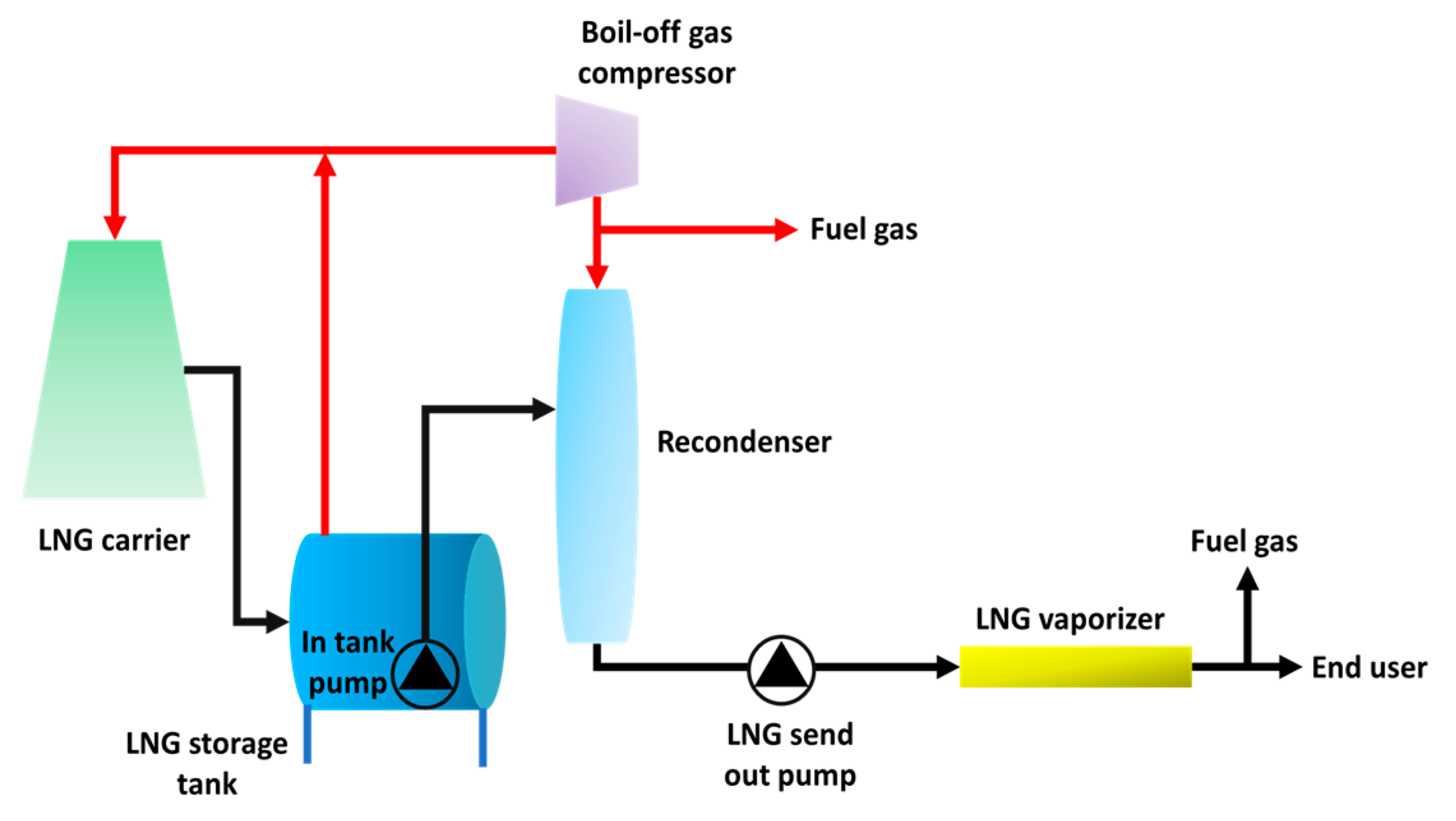
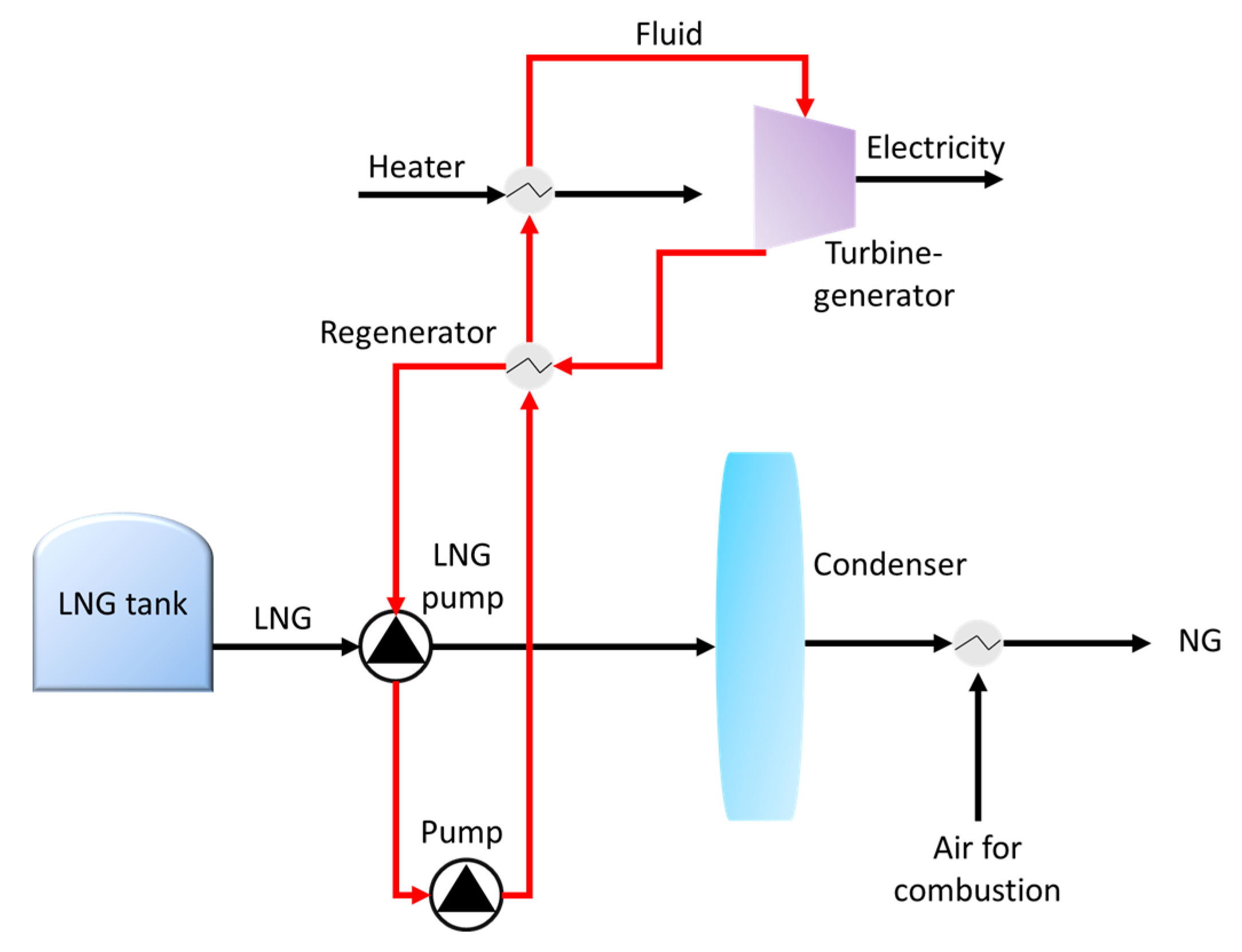
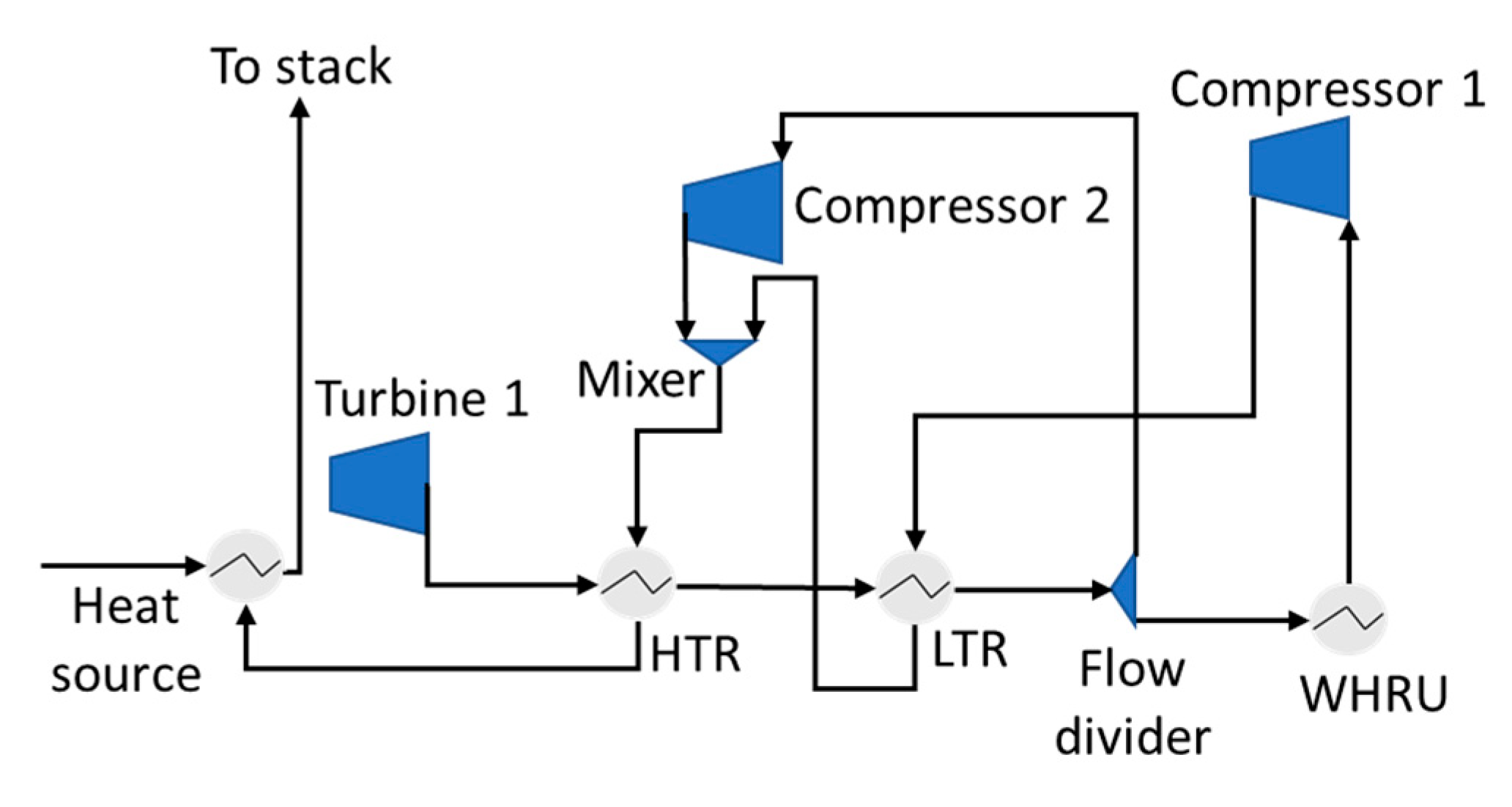
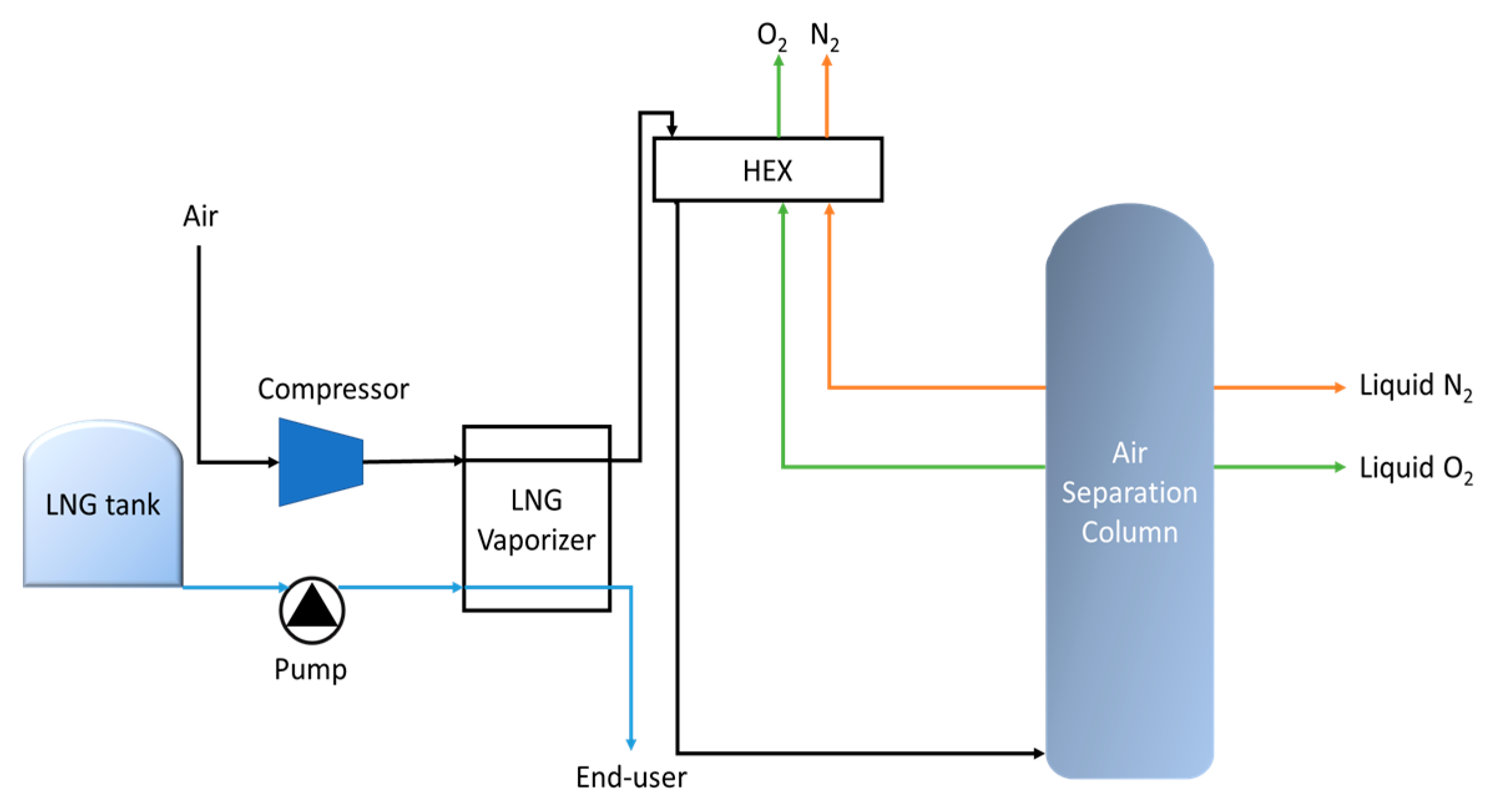

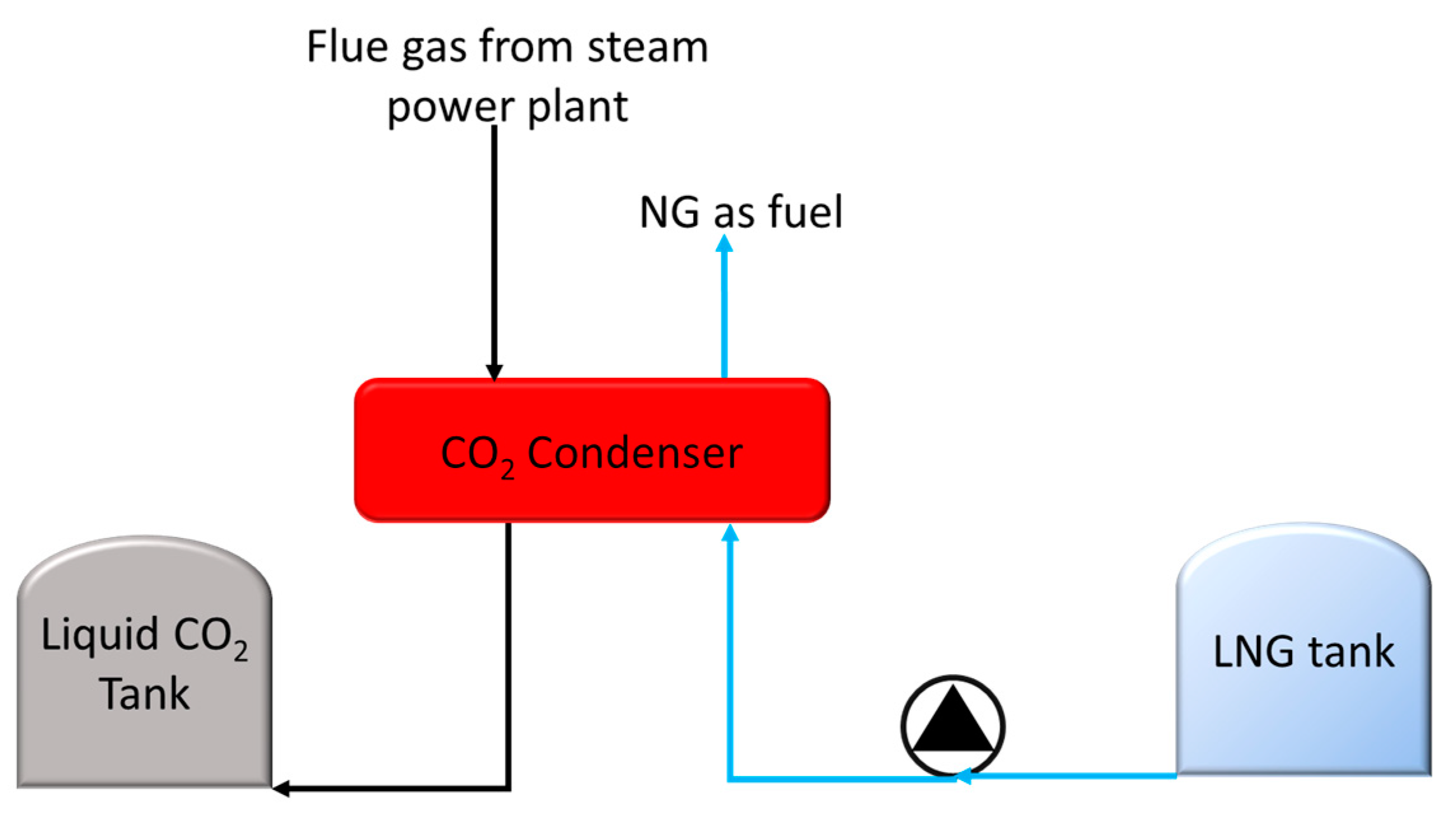

| Power Generated (MW) | Working Fluid | References |
|---|---|---|
| 3.773 | R290, R170, and R1150 | [45] |
| 31.67 | R290 | [46] |
| 2.456 | R290, R170, and R1150 | [47] |
| 0.470 | R290 and R1270 | [48] |
| N/A | Binary mixture (R1270 and C2H6) | [49] |
| 9.24 | R290 | [50] |
| System | References |
|---|---|
| Hydrogen liquefaction with dual-pressure Brayton cycle | [58] |
| Compressor inlet cooling of closed Brayton cycle (CBC) | [59] |
| Hydrogen liquefaction process using reverse Brayton cycle with steam methane reforming | [60] |
| System | Working Fluid | References |
|---|---|---|
| ASU | Neon, argon, oxygen, and nitrogen | [77] |
| LNG powered ship with ASU | Nitrogen and oxygen | [78] |
| ASU | Nitrogen and oxygen | [79] |
| ASU and hydrocarbon recovery | Nitrogen, oxygen, and argon. | [80] |
| ASU with power cycle | Oxygen | [81] |
| ASU | Oxygen | [82] |
| System | References |
|---|---|
| FD plant integrated with combined gas power cycle plant | [94] |
| FD plant integrated with floating storage regasification unit (FSRU) | [95] |
| Desalination unit integrated with compressed air energy storage (CAES) | [96] |
| Integration of Kalina cycle, Stirling engine, desalination unit, and magnetic refrigeration system | [97] |
| Desalination and power generation | [98] |
| System | References |
|---|---|
| ASU integrated with CO2 capture | [106] |
| Solar dish collectors with CO2 capture | [107] |
| Power generation with CO2 capture | [108] |
| CO2 capture and storage | [109] |
| Power generation with CO2 capture | [110] |
| Allam cycle power plant with CO2 capture | [111] |
Disclaimer/Publisher’s Note: The statements, opinions and data contained in all publications are solely those of the individual author(s) and contributor(s) and not of MDPI and/or the editor(s). MDPI and/or the editor(s) disclaim responsibility for any injury to people or property resulting from any ideas, methods, instructions or products referred to in the content. |
© 2023 by the authors. Licensee MDPI, Basel, Switzerland. This article is an open access article distributed under the terms and conditions of the Creative Commons Attribution (CC BY) license (https://creativecommons.org/licenses/by/4.0/).
Share and Cite
Noor Akashah, M.H.; Mohammad Rozali, N.E.; Mahadzir, S.; Liew, P.Y. Utilization of Cold Energy from LNG Regasification Process: A Review of Current Trends. Processes 2023, 11, 517. https://doi.org/10.3390/pr11020517
Noor Akashah MH, Mohammad Rozali NE, Mahadzir S, Liew PY. Utilization of Cold Energy from LNG Regasification Process: A Review of Current Trends. Processes. 2023; 11(2):517. https://doi.org/10.3390/pr11020517
Chicago/Turabian StyleNoor Akashah, Muhammad Haziq, Nor Erniza Mohammad Rozali, Shuhaimi Mahadzir, and Peng Yen Liew. 2023. "Utilization of Cold Energy from LNG Regasification Process: A Review of Current Trends" Processes 11, no. 2: 517. https://doi.org/10.3390/pr11020517
APA StyleNoor Akashah, M. H., Mohammad Rozali, N. E., Mahadzir, S., & Liew, P. Y. (2023). Utilization of Cold Energy from LNG Regasification Process: A Review of Current Trends. Processes, 11(2), 517. https://doi.org/10.3390/pr11020517









